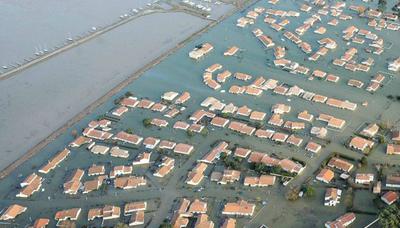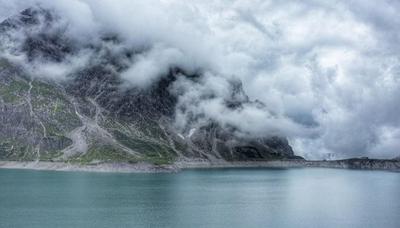Sea level rise
How is sea level rise set to evolve between now and 2050? What are the causes and consequences? What are the solutions? A guide to help you gain better understanding of this phenomenon.
Introduction
Human activities generate surplus heat both directly and indirectly. They emit gases which disrupt the natural greenhouse effect and lead to an increase in temperature on a planet-wide scale.
This atmospheric warming has two major impacts on the Ocean: on the one hand it causes land ice to melt and, on the other, it increases the temperature of the water which then expands. These phenomena provoke a gradual rise in water level which in the long term is likely to change the earth's geography.
The "Jet Star Roller Coaster" in Seaside Heights in New Jersey, submerged in water since Hurricane Sandy hit the East Coast of the United States on 29 October 2012.
The causes of sea level rise
Rising temperature
The temperature of the planet is continuing to increase due to human activities. These activities consume vast amounts of energy derived from fossil fuels (gas, coal and oil) which release large quantities of gas when they are burned. These gases form a layer which retains and concentrates the Earth's heat. They're known as greenhouse gases (GHGs).
GHG emissions started with the Industrial Revolution and have constantly increased ever since. Over the years, the natural greenhouse effect has intensified due to the increase in the volume of these man-made gases.
Consequently, the atmosphere's temperature is increasing: land ice is melting, sea water is expanding and the level of the Ocean is rising. This sea level rise is of course not uniform but directly threatens certain island territories and is also likely to change certain coastal areas.
Melting land ice
Under the influence of heat, ice sheets (accumulation of snow, glaciers, polar ice caps) continuously melt. This excess water from the continent is transferred to the Ocean, thereby increasing its level. It's important here to make the distinction between ice caps situated on the continents, and sea ice already present in the Ocean. If sea ice melts, which is already happening, this won't make sea levels rise: ice cubes melting in a glass of water never cause the water level to rise!
Sea water expansion
The intensification of the greenhouse effect increases not only the air temperature but also that of the Ocean, which is a vast heat reservoir on Earth.
There's therefore another lesser-known phenomenon at play, called the thermal expansion of water. When it's heated, water expands, meaning it takes up more room. For the same quantity of water, warm water takes up more volume than cold water. This expansion is not inconsequential as it's believed to account for between 30% and 50% of the global sea level rise.
What is sea level rise?
It's difficult for people to get a real sense of sea level rise as it's invisible to the naked eye. Scientists have been measuring it for several decades in order to assess the average level of the Ocean. Throughout the 20th century, sea levels rose at an average speed of 1.7 mm a year.
Today, this speed is increasing. Between 1993 and 2013, just 20 years, sea levels rose at a speed of 3.2 mm a year. Twice that observed throughout the whole of the 20th century! Moreover, levels are not rising at the same speed in all regions as the Ocean is not the same temperature everywhere, hence the existence of hot and cold currents. Only warm water expands, so the land situated near warm sea currents will be subject to a faster sea level rise than elsewhere.
How is the situation predicted to evolve between now and 2050?
One thing is certain, the rise of the level of the Ocean will continue to intensify. It's a fact and a large part of the scientific community agrees on this point. The question now is how to predict the scale of this increase over the decades to come.
By 2100, with a margin of error of more or less 25 cm, it's estimated that sea levels will rise by 25 cm in the best-case scenario and by 82 cm in the worst-case scenario. The latter figure is most often quoted as it is the one which demands more protection and adaptations.
On this point, although sea level rise is not in doubt, future scenarios are less certain. They may not correspond very closely to what will really happen. Indeed, it's difficult to predict the scale of sea level rise, due to:
- Poor knowledge of the complex processes of climate change;
- Uncertainty regarding future scenarios of man-made GHG emissions;
- Difficulty in estimating the conditions and the speed of ice melt;
- Impossibility to predict societies' reactions and the measures they will take to combat climate change.
What can we do?
What solutions can we implement to combat sea level rise?
- Reducing fossil fuel consumption
It's possible to slow down this phenomenon by reducing our consumption of energy which emits GHGs and choosing to use less harmful forms of energy, which do little or no damage to the environment and its natural greenhouse effect.
There are a host of other types of energy which have the benefit of not emitting GHGs: wind power, as seen with wind turbines producing electricity, the power of water and its currents as well as solar energy (plants and phytoplankton derive their energy from the sun). These are just some examples which offer a wide range of possibilities for reducing gas emissions while maintaining human activities.
- Good daily eco-friendly habits
It's also possible to fight against climate change and sea level rise by making very small changes in our everyday lives. They help to reduce our carbon footprint, meaning they lessen our contribution to climate change:
- Switch off lights and electrical appliances when they're no longer in use;
- Don't set the heating too high;
- Don't leave the tap running;
- Buy environmentally friendly products;
- Recycle as much waste as possible;
- Don't throw away batteries, bulbs and medicines with household waste;
- For short journeys, walk or cycle;
- Use public transport;
- Adopt environmentally friendly driving behaviour;
- Try car sharing;
- Take the train rather than the plane wherever possible.
FAQ
What is rising water levels?
Rising water levels are the result of rising sea levels. This rise is difficult to perceive in everyday life, as it is invisible to the naked eye. To be able to see it, scientists have taken measurements over several decades to assess the average level of the ocean. Throughout the 20th century, the water rose at an average rate of about 1.7 mm per year.
This is both a natural phenomenon, linked to the Earth's thermal cycle, and a result of human activities that contribute to climate change.
What are the causes of rising water levels?
Two factors, both linked to climate change, are responsible for the rise in water levels: the melting of the cryosphere (ice) and the expansion of water. Rising temperatures cause continental waters to melt (Antarctic polar ice caps, alpine glaciers, etc.), and these waters then flow into the oceans, causing the water to rise. The second factor, thermal expansion, occurs when water molecules move apart, increasing the volume of water.
What are the consequences of rising water levels?
The consequences of rising sea levels are many and far-reaching. Rising sea levels increase the frequency and impact of major storms. Indeed, according to the IPCC report (2019), events that used to occur once a century will occur every year by 2050 if climate change is not curbed. Also, rising sea levels lead to increased exposure to flood risks and thus to climatic migrations of populations living in coastal areas. Finally, rising sea levels are changing ocean ecosystems, both in terms of flora and fauna.






